|
MOUNT KAILASH - the abode of LORD Maheswara
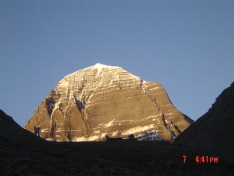 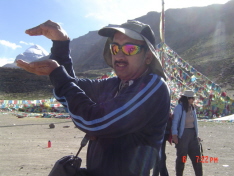 
Anyone who recognizes the Devine Force implicit in nature and views its sportive play cannot but praise its glory saying, "You are omniscient, You are omnipotent, You are behind every miracle of nature'. It is only when a Sadhaka realises that the whole world is the stage for God's cosmic play and surrenders to God's will that his Sadhana will become fruitful
- Swami Vivekananda
For most people, a trip to Western Tibet is virtually synonymous with a visit to Mount Kailash. The power of this strange, domed peak has gripped the imagination of the people of India and Tibet since time immemorial, with the result that it has long been one of Asiaís most important(and remote) pilgrimage destinations. More recently, Mount Kailshís reputation as a sacred mountain as well as a place of natural beauty has begun to lure travelers and pilgrims from around the world. Beginning in 1984, when the Chinese authorities first opened Tibet to the outside world, Western visitors (the first since Lama Govinda in 1949) have begun to make their way into the area in trucks, land cruisers, and even a horseback and by foot. Today, it is still extremely difficult to reach the region, and the obstacle that people meet in trying to get here are frequently attributed to the sacred power of the mountain itself, which allows only those with sufficient spiritual preparation to gain a glimpse of its magical presence.
Mount Kailash is remarkable in that four of the largest rivers in Asia have their sources within 100km (62 miles) of it; the indus flowing to the north, the Brahmaputra to the east, the Sutlej to the west, and the Karnali (leading to the Ganges) to the south. As a mountain in this part of the world it is not particularly high, a mere 6,714m yet it is striking in the way it rises above the surrounding range and remains perpetually snow-capped. The stunning image of this white peak against the clear blue sky helps to explain the mountainís name in Tibetan, Gang Rinpoche, or Jewel of Snow.
Each of Mount Kailash's faces reflects different moods. The southern face reflects majesty or splendour; it is fully covered with snow. The western face is enveloped in an aura of compassion and benevolence. The northern face is stark, forbidding and daunting, while the eastern, only visible from a long way off, is mysterious and distant.
Traditional Buddhist cosmology has often connected Kailash with Mount Meru, the great mythological mountain that forms the axis of our world system. As the center of this world system, Mount Meru is often visualized surrounded by the various continents and adorned with the sun and moon and then offered to the buddhas and bodhisattvas as a mandala. In addition to Buddhists, Indus, jains and Bonpo practitioners all hold Mount Kailash to be sacred. Hindus most frequently see the mountain as the abode of Shiva and his divine entourage. A well-known Sanskrit lyrical poem from the fifth century, The Cloud Messenger by kalidasa, pays tribute to the mountain and its surroundings thorough a message sent by an exiled denizen of Kailash to his wife via a passing cloud.
The Jains, whose own faith was founded at the time of the Buddha in India, regard Kailash as the place where the first Jain saint gained emancipation. Followers of the Bon tradition in Tibet worship the mountain as the spiritual center of the ancient country of Shangshung and as the place where their founder, Shenrab, descended to the earth from the sky. Because of these and other religious association, Hindu, Buddhist, Jain and Bon ascetics and pilgrims have been drawn to the mountain for thousands of years. Once they arrive they gaze upon it, circumambulate it and sometimes settle down to practice austerities and meditation. The 11th century Tibetan Buddhist saint Milarepa is said to have resided there for 11years. Padmasambhava is also associated with the mountain, particularly the valley on the western side, where he stayed in a cave.
"Ratnasanu sharaasanum Rajatadri Shrunga Niketanam
Singinikruta Pannageshwara Achutanana Sayakam |
Kshipradagda Puratrayam Tridivalairabi Vandhitam
Chandrashekaramashraye mama kim karishyati vyiamaha ||
In this way, Srimad Shankaracharya in his Chandrashekara Astaka glorifies the abode of Ishwara - the Holy Mt. Kailash. Even "Yama" the life taker can not touch the devotees who worship Parashiva he claims. This is Kubera's living place also. After his brother Ravana takes control of Lanke and pushpaka vimana, Kubera with the blessings from parameshwara establishes Alakapuri in Kailash and becomes Yaksharaja.
It is described in the Mahabharatha that Bhagavan Krishna went along with the pandavas and Dhoumya Maharshi to Kailas from Badrinath. On reaching there after fifteen days they were welcomed by Lord Mahadeva Himself whose darshan and hospitality made them very happy. This is an example of the fact that Lord Mahadeva gives darshan only to deserving people.
"In Life, one gets what one deserves and not what one desires and He knows what one deserves - Swami Chinmayananda
Our ancients like Vyasa and great ones of recent times like Kalidasa have described this Kailas as the dear abode of Lord Mahadeva.
The Kailas peak full of dark black rocks with head adorned with glittering white snoe stood like a leader amongst the long stretch of black mountains. "My body experienced horripulation and my mind immersed in the ocean of bliss was overcome with joy" - Sri Swami Tapovanam
I started walking slowly with my eyes pinned on to the lovely forehead of the Mount Kailsh. I started walking forward but my eyes, being rooted on the beautiful forehead of the Kailasa Montain, were incapable of looking here and there or even determining the path to be taken - Sri Swami Tapovanam
Ye samprapthaha param stanam Dyana Yogarata Naraaha |
Na tesham punravrutti Grore samsara sagare ||
Sarvagra sarvadha shuddha paripurna Maheshwaraha |
Shiva tulya balopethaha param Shivapuram Gathaha ||
Ithtanthena theshu Kailaseshu vastum Shilamasyasthiti Kailasa vasi |
- Shivatatva Rahasya by Chikkeruru Linga Jois
It is mentioned in 'Shiva Dharmottra" that there is a separate Loka called 'Paramashiva Loka' which is accessible to only dyana yogis. Those dyana yogis who embrace this paramashiva Loka will not return to "samsara" sagara. They attain full satisfaction and live in total Bliss.
Yo veda dav svara proktho | Vedante cha pratishtithaha |
tasya prakruti Linasya | Ya paraha sa Parameshwaraha ||
Those who the veda svara's are refering to, those who are proficient in vedas, His oneness with Nature, who is GREAT is Maheshwara. When you visit Mt. Kailash - the Abode of LORD Maheshwara you can experience this total truth. We have to become one with Nature to get close to LORD. Mt. Kailash is Shiva and Shiva is Mt. Kailash.
Aham Brahmasmi, Shivaha kevaloham - Chidananda Rupam | Shivoham | Shivoham |
CIRCUMAMBULATION (KORA) OF MOUNT KAILASH
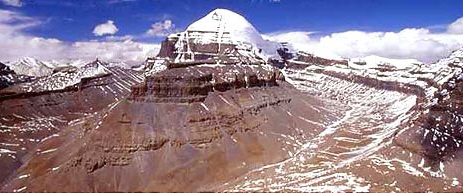
 
It is the goal of every pilgrim to Kailash to walk at least once around the base of the sacred mountain. This act of circumambulation, or kora in Tibetan and parikrama in Sanskrit, is considered to hold great powers of purification for the pilgrim. Some say that by completing the route just once, a person can purify the effects of all the negative actions of the present lifetime. Of course, the degree of purification can be increased by further trials around the mountain, with the most merit accrued to those who perform prostrations along the entire length of the circumambulation route.
Even if you do not plan to prostrate around the mountain, however, it is still necessary to be properly equipped and prepared before undertaking the arduous trek around the mountain. A waterproof and windproof jacket, strong shoes, sleeping bag, ground sheet, tent, stove, fuel, cooking pot, water bottle and sufficient food for at least three days are all essential. Rain, hail, and even snow storms can be common, especially from June to September. It is generally not possible to complete the circuit before April or after October as the high Drolma Pass is blocked by snow. Binoculars and copies of The Sacred Mountain by John Snelling and Wanderings in the Himalayas by Sri Swami Tapovanam will greatly enhance your perception and appreciation of what you see and experience on your trip around the mountain.
Although many hardy Tibetan pilgrims complete the 51km long(32mile) circumambulation route in one day, less robust pilgrims should definitely take a slower pace, as should visitors who wish to contemplate the scenic beauty and absorb the various subtle moods and ever changing atmosphere of the mountain. Even if one walks fairly quickly, the circumambulation can easily take two full days, with one overnight stay at Dri-raPuk. (The Tibetan one-dayers leave at 4A.M. and arrive back at midnight.) A three-day itinerary enables you to enjoy the trek at a relatively relaxed pace, with stopovers at Dri-ra Puk and Zutrul Puk. Description of the route here follows the three-day plan. Four to five-day itineraries allow you to stop when and where you wish and to take a few side detours. Some of these detours are located on the so-called inner route (nangkor) and are considered best visited only after one has already circumambulated the mountain on the main or outer route 12 times or more!
The route around the Mount Kailash takes you past a number of small monasteries. Most of these were badly damaged or even destroyed during the Cultural Revolution and were later rebuilt during the 1980s. Also along the route are sites connected with the great saints and other figures of Buddhism, Hinduism, Jainism and Bon. The landscape is strewn with footprints and handprints in the rock, said to have been left there by meditation masters and buddhas and many of the natural formations on and around Kailash have come to be associated with the ritual implements and other attributes of such great beings. Mount Kailash also sports many other extraordinary formations: on the peaks and ridges are needles, points and protuberances, some of which are said to be stupas.
The staging point for the circumambulation is the sheep-trading station and tent town of Darchen, situated 6km (4miles) off the main Shiquanhe-Purang road, north of Barga, nestling at the foothills of Kailash. Darchen itself holds little of interest, although there is a small kagyo monastery in poor repair. A small bazaar has sprung up consisting of several dozen makeshift shops and stalls run by itinerant Khampa and nomad traders and a good variety of basic supplies is available, as well as the usual religious artifacts and ethnic jewelry. There are also foodstalls, tea shops with pool tables and marvelous views of Ghurla Mandhata to the south. Two new tourist and pilgrim hotels have been built, one owned by the police department with about ten rooms, the other a tourist company hotel with about 18rooms. You can also arrange for yaks or other pack animals to carry your gear n Darchen if necessary. Many people set out on the kora from Darchen itself, but it is not uncommon for people to continue in vehicles to Tarpoche and start the actual trek around the mountain from there.
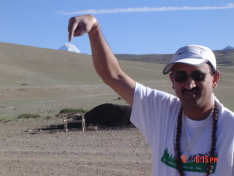 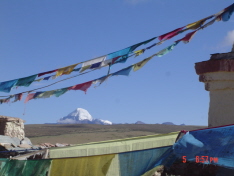 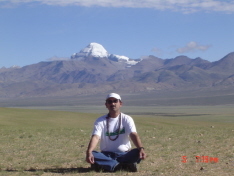
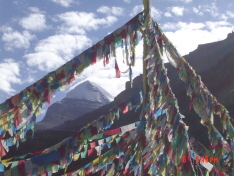  
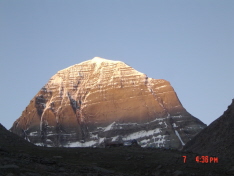 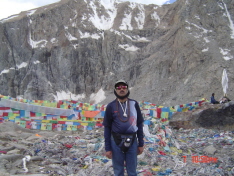 
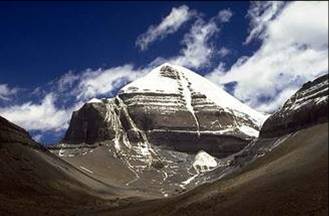
Where ego asserts, Lord vanishes
When ego vanishes, Lord enters
- Swami Chinmayananda |




